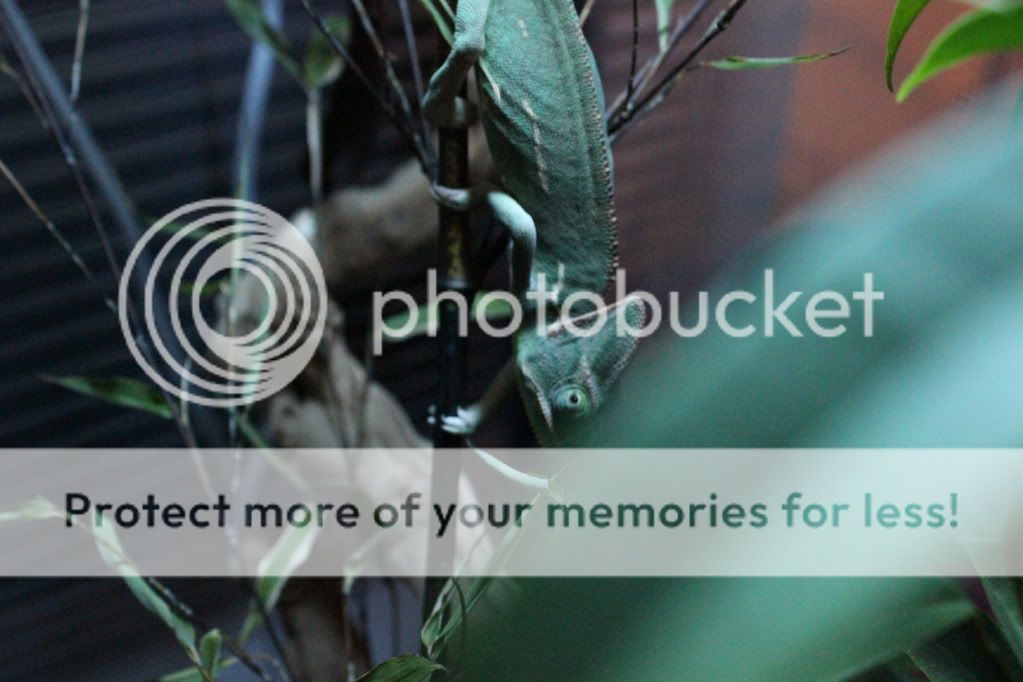Jakama
Member
I have been a chameleon owner for about a month. When I first purchased my chameleon, I had very poor husbandry- poor light placement, not enough foliage, only fed her mealworms, used substrate, etc. Over the past month, however, I have been taking numerous suggestions from this community and have gotten my husbandry to an acceptable level, I think. Despite this, I have not been an owner for long enough to be particularly confident in my abilities, and I figured that, after all these renovations, it would be fitting to check with the community to see if there are any more changes I need to make before I can settle in and relax.
Mainly what concerns me now is that she looks a bit thin, and that I have noticed a bulge that seems like it might be eggs, but she does not have yellow spots on her sides. Also, she gets a black and white-ish coloration whenever she goes up to her basking spot, which I have heard means that a chameleon is stressed.
Info sheet:
Female veiled chameleon, about five months old. Owned her for four weeks. I handle her about one time every week. I feed her medium to large crickets- about ten per day on a normal day. I feed the crickets fresh carrots and green beans, with the occasional mango slice. I dust them with Zoomed Repti Calcium without D3, and twice a month with Calcium with D3. Soon I will be purchasing multivitamins as another dusting supplement, which I will use twice a month. I mist her twice a day with hot water (comes out lukewarm), and I have a cup of water with a hole in it that I fill up about once a day. I do see her drinking water from this. Fecal matter is dark brown, sometimes with a white section. I have never tested her for parasites. She received a burn on her left side on the second day we got her, but the situation that caused this has been remedied- I moved the lamp.
Cage is about 24x24x36 inches, wire mesh. During the day, I use a 60W house lamp and a 15W UVB tube lamp (33% UVA, 10% UVB). At night it gets pretty cold, so I use a space heater to keep the temperature at about 60 degrees. I switch it to daytime lighting at around 8:00 AM, and switch it to nighttime lighting at around 8:00 PM. I am using two live ficus in my enclosure, as well as a climbing vine, a large piece of driftwood, a piece of bamboo with numerous shoots, and a fake bush. I keep the temperature in the enclosure between 70 and 85 degrees Fahrenheit, and I try and keep the humidity at around 60%. The temperature of her basking spot is about 80 degrees. The table that the enclosure is resting on is about three feet off of the floor. I keep her enclosure in my room, and people do tend to walk around this room several times a day. This provides the advantage of being able to keep an eye on her throughout the day. Her enclosure is next to a window, so she gets plenty of natural light during the day in addition to her two normal lights. This window is always closed, but I keep the blinds open. The sun never shines directly through this window. I am located in Sonoma County in California. I live about an hour north of San Francisco.
Pictures:





P.S. Sorry about asking all these questions, I really appreciate your guys' input.
Mainly what concerns me now is that she looks a bit thin, and that I have noticed a bulge that seems like it might be eggs, but she does not have yellow spots on her sides. Also, she gets a black and white-ish coloration whenever she goes up to her basking spot, which I have heard means that a chameleon is stressed.
Info sheet:
Female veiled chameleon, about five months old. Owned her for four weeks. I handle her about one time every week. I feed her medium to large crickets- about ten per day on a normal day. I feed the crickets fresh carrots and green beans, with the occasional mango slice. I dust them with Zoomed Repti Calcium without D3, and twice a month with Calcium with D3. Soon I will be purchasing multivitamins as another dusting supplement, which I will use twice a month. I mist her twice a day with hot water (comes out lukewarm), and I have a cup of water with a hole in it that I fill up about once a day. I do see her drinking water from this. Fecal matter is dark brown, sometimes with a white section. I have never tested her for parasites. She received a burn on her left side on the second day we got her, but the situation that caused this has been remedied- I moved the lamp.
Cage is about 24x24x36 inches, wire mesh. During the day, I use a 60W house lamp and a 15W UVB tube lamp (33% UVA, 10% UVB). At night it gets pretty cold, so I use a space heater to keep the temperature at about 60 degrees. I switch it to daytime lighting at around 8:00 AM, and switch it to nighttime lighting at around 8:00 PM. I am using two live ficus in my enclosure, as well as a climbing vine, a large piece of driftwood, a piece of bamboo with numerous shoots, and a fake bush. I keep the temperature in the enclosure between 70 and 85 degrees Fahrenheit, and I try and keep the humidity at around 60%. The temperature of her basking spot is about 80 degrees. The table that the enclosure is resting on is about three feet off of the floor. I keep her enclosure in my room, and people do tend to walk around this room several times a day. This provides the advantage of being able to keep an eye on her throughout the day. Her enclosure is next to a window, so she gets plenty of natural light during the day in addition to her two normal lights. This window is always closed, but I keep the blinds open. The sun never shines directly through this window. I am located in Sonoma County in California. I live about an hour north of San Francisco.
Pictures:





P.S. Sorry about asking all these questions, I really appreciate your guys' input.
